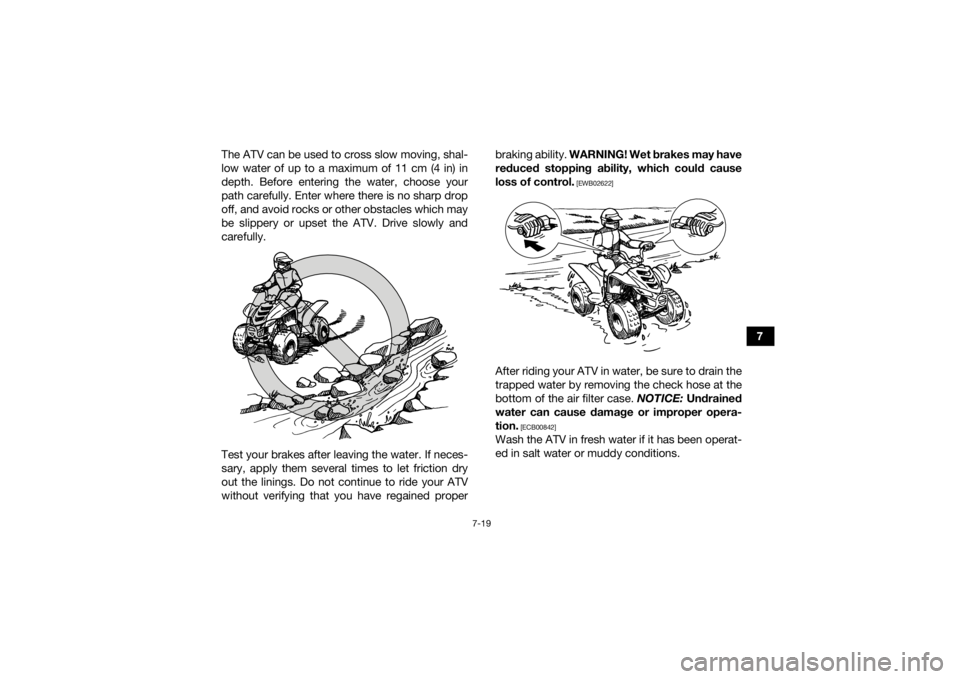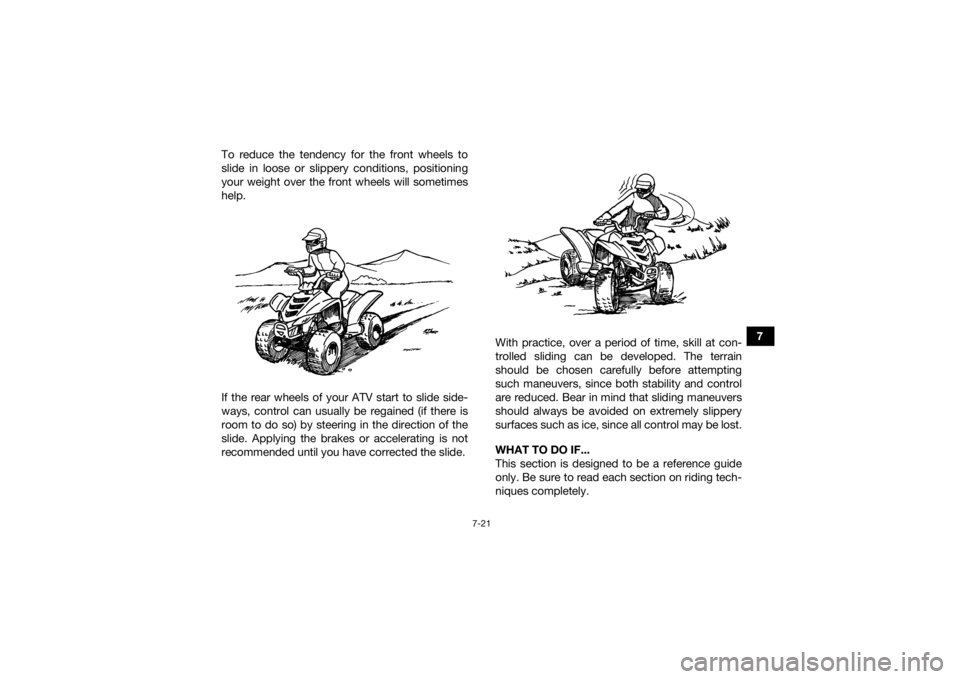2017 YAMAHA YFZ50 brakes
[x] Cancel search: brakesPage 79 of 132

7-19
7
The ATV can be used to cross slow moving, shal-
low water of up to a maximum of 11 cm (4 in) in
depth. Before entering the water, choose your
path carefully. Enter where there is no sharp drop
off, and avoid rocks or other obstacles which may
be slippery or upset the ATV. Drive slowly and
carefully.
Test your brakes after leaving the water. If neces-
sary, apply them several times to let friction dry
out the linings. Do not continue to ride your ATV
without verifying that you have regained proper braking ability.
WARNING! Wet brakes may have
reduced stopping ability, which could cause
loss of control.
[EWB02622]
After riding your ATV in water, be sure to drain the
trapped water by removing the check hose at the
bottom of the air filter case. NOTICE: Undrained
water can cause damage or improper opera-
tion.
[ECB00842]
Wash the ATV in fresh water if it has been operat-
ed in salt water or muddy conditions.
UBW460E0.book Page 19 Monday, May 23, 2016 11:12 AM
Page 81 of 132

7-21
7
To reduce the tendency for the front wheels to
slide in loose or slippery conditions, positioning
your weight over the front wheels will sometimes
help.
If the rear wheels of your ATV start to slide side-
ways, control can usually be regained (if there is
room to do so) by steering in the direction of the
slide. Applying the brakes or accelerating is not
recommended until you have corrected the slide.
With practice, over a period of time, skill at con-
trolled sliding can be developed. The terrain
should be chosen carefully before attempting
such maneuvers, since both stability and control
are reduced. Bear in mind that sliding maneuvers
should always be avoided on extremely slippery
surfaces such as ice, since all control may be lost.
WHAT TO DO IF...
This section is designed to be a reference guide
only. Be sure to read each section on riding tech-
niques completely.
UBW460E0.book Page 21 Monday, May 23, 2016 11:12 AM
Page 82 of 132

7-22
7WHAT TO DO...
If your ATV doesn’t turn when you want it to:
Bring the ATV to a stop and practice the turning
maneuvers again. Be sure you are putting your
weight on the footboard to the outside of the
turn. Position your weight over the front wheels
for better control. (See page 7-12.)
If your ATV begins to tip while turning:
Lean more into the turn to regain balance. If
necessary, gradually let off the throttle and/or
steer to the outside of the turn. (See page 7-12.)
If your ATV starts to slide sideways:
Steer in the direction of the slide if you have the
room. Applying the brakes or accelerating is not
recommended until you have corrected the
slide. (See page 7-20.)
If your ATV can’t make it up a hill you are trying
to climb:
Turn the ATV around if you still have forward
speed. If not, stop, dismount on the uphill side
of the ATV and physically turn the ATV around.
If the ATV starts to slip backwards, DO NOT
USE THE REAR BRAKE – the ATV may tip over
on top of you. Dismount the ATV on the uphill
side. (See page 7-13.)
If your ATV is traversing a sloping surface:
Be sure to ride with your weight positioned to-
wards the uphill side of the ATV to maintain
proper balance. If the ATV starts to tip, steer
down the hill (if there are no obstacles in your
way) to regain balance. If you discover that the
ATV is going to tip over, dismount on the uphill
side. (See page 7-17.)
If your ATV encounters shallow water:
Ride slowly and carefully through slow moving
water, watching for obstacles. Be sure to let wa-
ter drain from the ATV and CHECK YOUR
BRAKES FOR PROPER OPERATION when you
come out of the water. Do not continue to ride
your ATV until you have regained adequate
braking ability. (See page 7-18.)
UBW460E0.book Page 22 Monday, May 23, 2016 11:12 AM
Page 104 of 132

8-22
84. Tighten the locknut.
5. Slide the rubber covers to their original posi-
tions.
EBU24061Valve clearanceThe valve clearance changes with use, resulting in
improper air-fuel mixture and/or engine noise. To
prevent this from occurring, the valve clearance
must be adjusted by a Yamaha dealer at the inter-
vals specified in the periodic maintenance and lu-
brication chart.
EBU29602BrakesReplacement of brake components requires pro-
fessional knowledge. Brake service should be
performed by a Yamaha dealer.
WARNING
EWB02572Operating with improperly serviced or adjust-
ed brakes could lead to a loss in braking ability
and an accident. EBU34511Checking the front and rear brake
shoesThe front and rear brake shoes must be checked
for wear at the intervals specified in the periodic
maintenance and lubrication chart. Without disas-
sembling the brake, this can be performed by
checking the position of the brake lever free play
adjusting bolts or nut.
Front brakes
To check front brake shoe wear, check the posi-
tion of the adjusting bolts. If a bolt extends more
than 12 mm (0.47 in) from its locknut, the brake
shoes need to be replaced.
1. Rubber cover
2. Throttle lever free play adjusting nut
3. Locknut
4. Throttle lever free play
1
2
3
1
4
(a)(b)
UBW460E0.book Page 22 Monday, May 23, 2016 11:12 AM
Page 121 of 132

9-1
9
EBU25861
CLEANING AND STORAGE
EBU25903CleaningFrequent, thorough cleaning of your ATV will not
only enhance its appearance but will improve its
general performance and extend the useful life of
many components.1. Before cleaning the ATV: a. Block off the end of the exhaust pipe toprevent water entry. A plastic bag and
strong rubber band may be used.
b. Make sure the spark plug and all filler caps are properly installed.
2. If the engine case is excessively greasy, apply degreaser with a paint brush. Do not apply
degreaser to the chain, sprockets or wheel
axles.
3. Rinse the dirt and degreaser off with a garden hose. Use only enough pressure to do the
job. WARNING! Wet brakes may have re-
duced stopping ability, increasing the
chance of an accident. Test the brakes af-
ter washing. Apply the brakes several
times at slow speeds to let friction dry out
the linings.
[EWB02312]
NOTICE: Excessive wa- ter pressure may cause water seepage
and deterioration of wheel bearings,
brakes, transmission seals and electrical
devices. Many expensive repair bills have
resulted from improper high-pressure de-
tergent applications such as those avail-
able in coin-operated car washers.
[ECB00712]
4. Once most of the dirt has been hosed off,
wash all surfaces with warm water and mild,
detergent-type soap. An old toothbrush or
bottle brush is handy for hard-to-reach pla-
ces.
5. Rinse the ATV off immediately with clean wa- ter and dry all surfaces with a chamois, clean
towel or soft absorbing cloth.
6. Dry the chain and lubricate it to prevent it from rusting.
7. Clean the seat with a vinyl upholstery cleaner to keep the cover pliable and glossy.
8. Automotive type wax may be applied to all painted and chrome plated surfaces. Avoid
combination cleaner-waxes. Many contain
UBW460E0.book Page 1 Monday, May 23, 2016 11:12 AM
Page 130 of 132

12-1
12
INDEX
AAccessories and loading ................................................ 6-5
Air filter element, cleaning ............................................ 8-16BBattery .......................................................................... 8-32
Brake lever free play, adjusting the front ..................... 8-23
Brake lever free play (rear), adjusting ........................... 8-25
Brake lever, front ............................................................ 4-5
Brake lever, rear ............................................................. 4-6
Brake levers, checking and lubricating ........................ 8-29
Brakes .......................................................................... 8-22
Brakes, front and rear .................................................... 5-3CCables, checking and lubricating ................................. 8-29
Carburetor, adjusting ...................................................8-20
Chassis fasteners ........................................................... 5-6
Cleaning ......................................................................... 9-1DDrive chain ..................................................................... 5-3
Drive chain, cleaning and lubricating ........................... 8-28
Drive chain slack .......................................................... 8-26EEngine break-in .............................................................. 6-3
Engine, cold start ........................................................... 6-1
Engine idling speed ...................................................... 8-20
Engine oil .............................................................. 5-3, 8-11
Engine, starting a warm ................................................. 6-3
Engine stop switch ......................................................... 4-1
Engine stop switch with lanyard .................................... 4-2
FFront and rear brake shoes, checking ......................... 8-22
Front arm pivots, lubricating ........................................ 8-30
Front knuckle pivots, lubricating .................................. 8-31
Fuel ........................................................................ 4-8, 5-3
Fuel cock ...................................................................... 4-10
Fuel tank cap ................................................................. 4-8
Fuse, replacing ............................................................. 8-35HHandlebar switches ....................................................... 4-1IIdentification numbers ................................................. 11-1
Instruments and switches .............................................. 5-6KKickstarter ...................................................................... 4-7LLabel locations ............................................................... 1-1MMain switch .................................................................... 4-1
Maintenance and lubrication chart ................................ 8-5
Maintenance chart, emission control system ................ 8-3
Model label .................................................................. 11-1OOwner’s manual and tool kit .......................................... 8-2PPanel, removing and installing ....................................... 8-9
Parking ........................................................................... 6-3
Parking brake ................................................................. 4-6
Parking on a slope ......................................................... 6-4
UBW460E0.book Page 1 Monday, May 23, 2016 11:12 AM